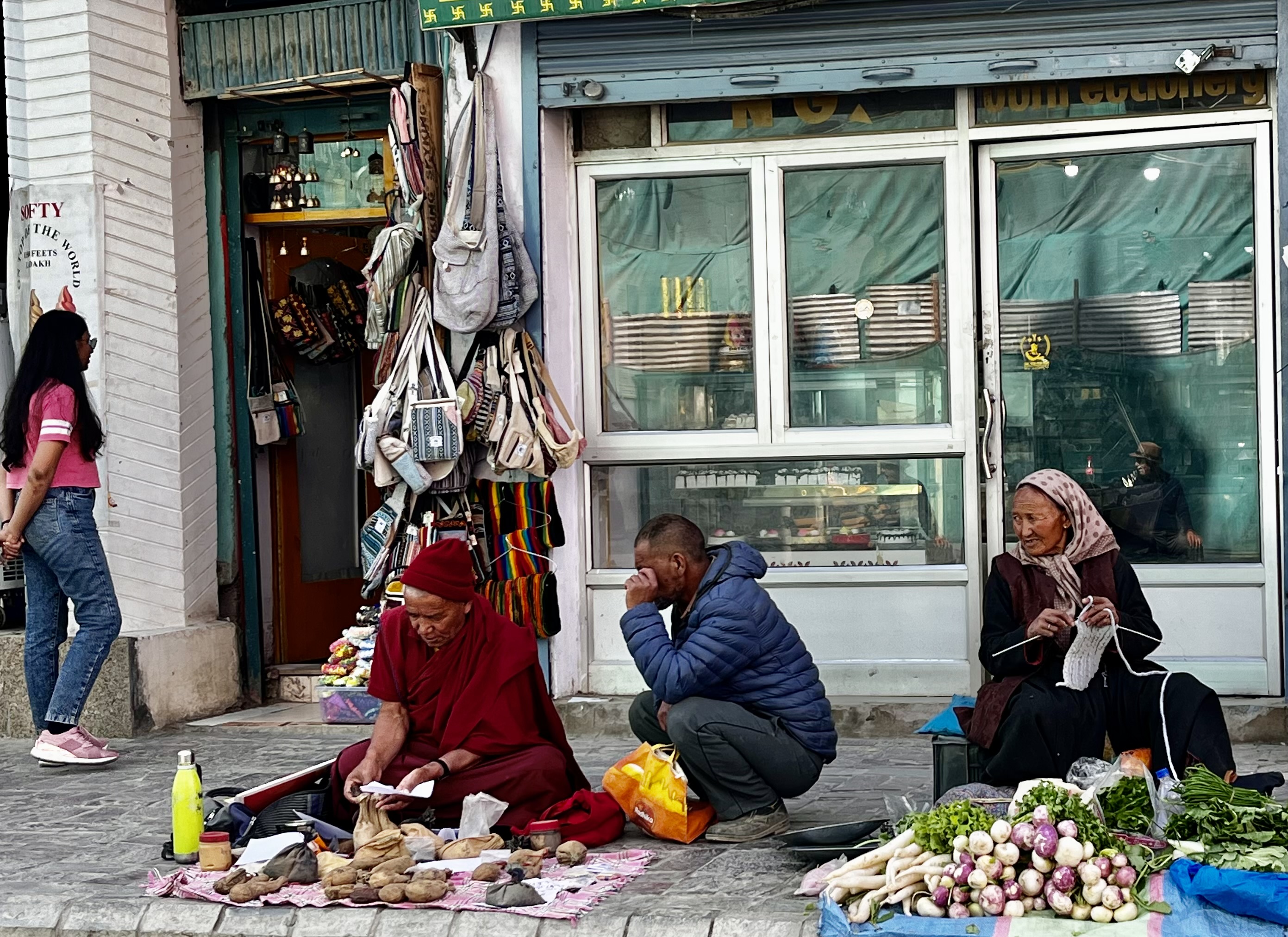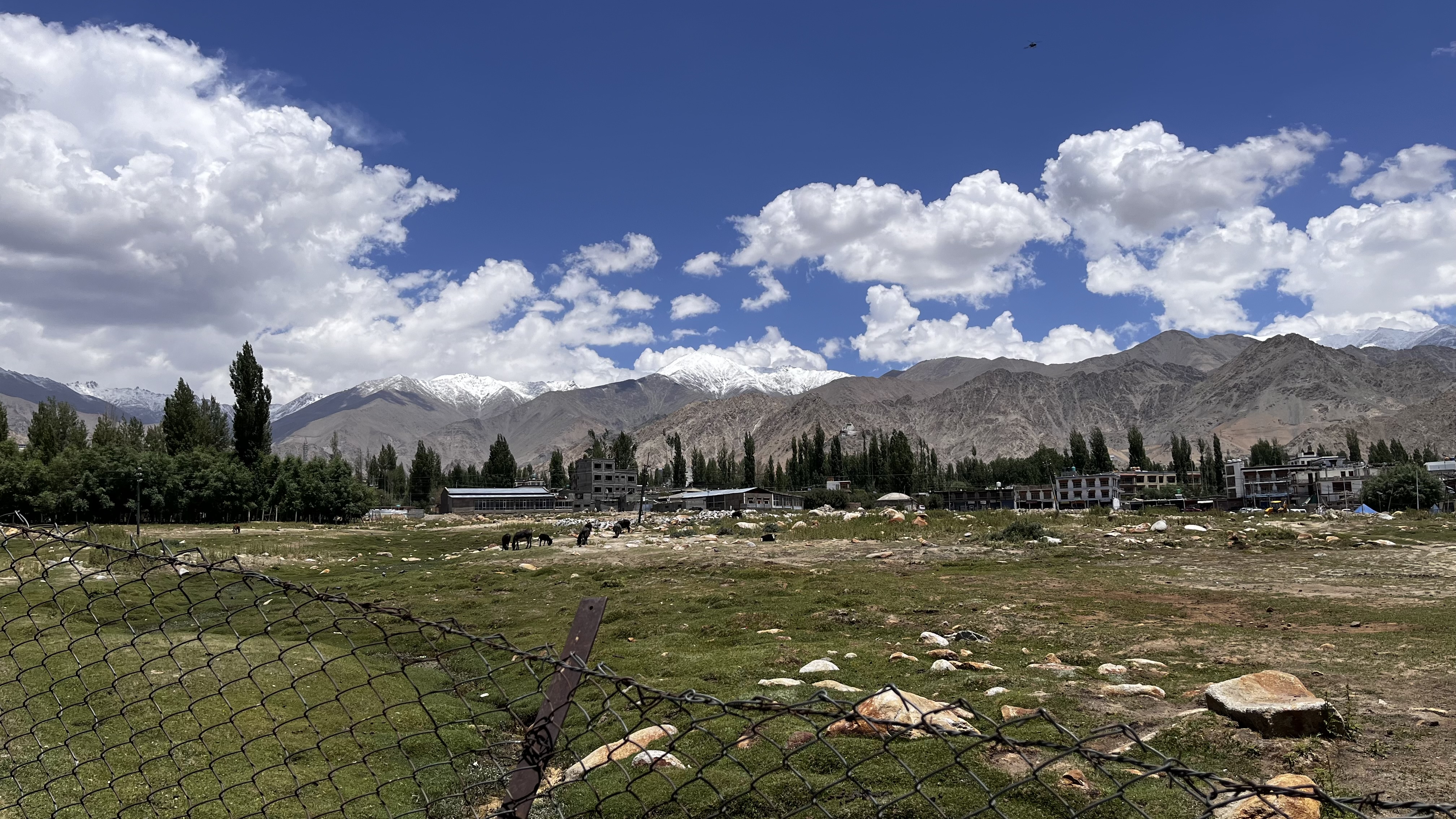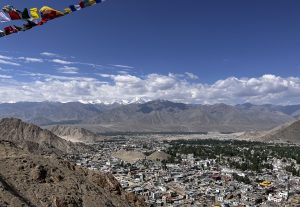LEH, LADAKH, INDIA — Padma Stanzin has various odd jobs that he needs to do before he can finally sit down to complete the coursework for his Master’s in Sociology degree. Stanzin, 28, resides in Ladakh, a region located on the China-India border, where many like him are on the hunt for opportunities to earn the bare minimum.
On March 8, Sonam Wangchuk, a prominent environmentalist, began a hunger strike, braving extreme sub-zero temperature under open skies, where thousands of locals like Stanzin joined him.
Wangchuk fasted for 21 days, to send a message to the government of India: that Ladakh was disenchanted at the kind of neglect the border region had been enduring under Prime Minister Narendra Modi.

With unemployment high, many Ladakhis are on the hunt for opportunities to earn the bare minimum. Photo by Tarushi Aswani.
Unemployed, Uncertain
Jigmet Paljor, a youth activist from Ladakh, regularly receives calls from locals in distress, who want to discuss the rising rate of unemployment in the region.
“Since 2019, Ladakh’s youth had high expectations, but even till today, the government has not planned anything to create more employment opportunities for us,” Paljor told The Diplomat.
In 2019, the Modi government moved a resolution in the Indian Parliament to scrap Article 370 of the Indian constitution, which stripped the state of Jammu and Kashmir of its special status. The government also moved a bill that divided the state into two union territories (UTs), Jammu and Kashmir as one and Ladakh as the other.
Overnight, the government ripped apart regions that had existed as one ever since Britain’s colonial rule over undivided India.
Chhering Dorje Lakrook, a former Bharatiya Janata Party (BJP) leader and minister in the erstwhile state of Jammu and Kashmir, is appalled at the way the government has been ignoring Ladakh and its people since the massive shake-up of 2019.
Lakrook, who is also president of the Leh Buddhist Association, explained to The Diplomat that the recent protests were a way to reflect for Ladakh’s people to express their anger toward the apathy shown by the government. “For several years, Ladakh wanted to exist as a separate governed region. We got that, but it is hollow. The government has looked away, we feel cheated,” he said.
After Ladakh was separated from Jammu and Kashmir, Lakrook continued, “That is when the mess began, 97 percent of us locals are indigenous people, the government is not giving us the safeguards needed. We are upset at the government; it is them who have made us come on the streets for our constitutionally guaranteed rights.”
To many Ladakh residents, the situation has actually regressed since their region was made a separate UT. “It has been five years, we still don’t have a recruitment system. Administratively, we had all this sorted when we were part of J&K,” Lakrook lamented.
In 2023, it was revealed in a government survey that 26.5 percent of graduates in Ladakh were unemployed.

Over four years, India and China have held 16 rounds of talks between their armies but failed to reduce the tensions. Photo by Tarushi Aswani.
Worried in a Warzone
The concerns about unemployment and economics are exacerbated by a feature unique to Ladakh: a tense military stand-off between India and China along their disputed border.
In June 2020, tensions along the Line of Actual Control (LAC), which is the de facto border between India and China, reached a peak when rare hand-to-hand combat in Ladakh’s Galwan Valley culminated in the killing of 20 Indian and four Chinese soldiers. It was the worst military skirmish between the two nuclear powers in 45 years.
The LAC passes through Pangong Tso, a landlocked, boomerang-shaped lake spanning 134 kilometers. One-third of this lake lies inside Indian-held territory while the remaining is under Chinese control. The western end of Pangong Tso is 53 kilometers southeast of Leh, the main city in Ladakh. A Chinese bridge – China’s second – is being constructed over the lake just 24 kilometers east of the LAC.
Since the skirmish that unfolded in 2020, India and China have both reinforced their troop positions near the LAC. Today, the two countries are still facing off, albeit across a buffer zone. Despite multiple levels of talks, disagreement persists at Demchok and Depsang – here China’s People’s Liberation Army (PLA) soldiers thwart the Indian Army from accessing areas that were previously patrolled by it.
With the PLA standing strong and exacerbating their buildup along the LAC, nomadic residents in nearby villages are worried about the future of their lives and livelihoods.
Konchok Stanzin, a councilor from a nomadic family from Chushul, a border village in eastern Ladakh, told The Diplomat that the families in the border districts were having to choose between survival and starvation. “We have lost grazing rights; our shepherds cannot earn anymore. They’re selling all their cattle to survive,” he said.
While the Modi government has been refuting reports of land being captured by the Chinese, shepherds like Stanzin testify to the theft of land.
In particular, the Durbuk-Shyok areas have been witnessing movement by both the PLA and Chinese nomads on the border. N. Namgial, a former councillor and shepherd from the border villages in the Durbuk-Shyok areas, feels that Modi’s BJP is fully responsible for plunging Ladakh into the chaos.
“All our grazing land, Ladakh’s land, where our ancestors took cattle has now been converted into a buffer zone. Ladakh’s nomads cannot access those areas since 2020. But the Chinese, with their ‘one-inch’ policy, have been settling their nomads and armies in those very zones” Namgial said.
Chinese officials, including President Xi Jinping himself, have repeatedly asserted that China will not cede “even one inch” of territory, whether in its border dispute with India or in the disputed South China Sea.
Nomads claim that ever since the Indo-China War of 1962, Ladakh has been rapidly shrinking. The last four years have further dwindled the area claimed as Indian territory in eastern Ladakh – despite the combat with India, China has been continuing to make inroads into Ladakh.

The BJP’s headquarters in Ladakh. Photo by Tarushi Aswani
Awaiting Rights, Guarantees
Aside from better job prospects and defense of Indian soil, the protests undertaken by locals also called for statehood for Ladakh and tribal status under the sixth schedule of the Indian Constitution. The sixth schedule permits the formation of autonomous development councils — with legislative, judicial and executive authority — in areas with dominant tribal populations. The councils can frame laws, including those for inheritance, marriage, police, village administration, and on agendas like management of land, forests, water and mining.
This, protesters say, is of immense value for the 97 percent tribal population that inhabits the region.
In Ladakh, the recent general elections resulted in the ouster of Jamyang Tsering Namgyal, a BJP politician who has always lavished Modi with praise for finally separating Ladakh from Jammu and Kashmir. Not only did Ladakhis vote out Namgyal but they also elected Mohmad Haneefa, an independent candidate who is sympathetic toward the struggle of soldiers guarding India’s borders and Ladakhis alike.
“There is anger in Ladakh, as a region which is on the border. The government should tend to our demands, which are fully under constitutional ambit and validated by law. Since 2019, we are staring at a loss of power over livelihoods and community rights,” Haneefa said.
As for Sonam Wangchuk, the man who led Ladakh into a massive protest movement, he feels that there is rising anxiety in Ladakh about a probable demographic shift and damage to the fragile Himalayan ecosystem. Kashmiris have also expressed similar concerns following the loss of Jammu and Kashmir’s special status in 2019. Wangchuk told The Diplomat that being granted sixth schedule status would safeguard Ladakh from demographic changes and resource exploitation by outsiders.
Upon being asked why the BJP government had made no significant pass at resolving the ruckus in the region, Wangchuk hinted at the possibility that the Modi government might have been under pressure from capitalists interested in exploiting Ladakh’s resources. This, he said, might have stopped the government from engaging with Ladakh’s problems.
As Modi embarks upon his third tenure as prime minister, India’s military stand-off with China has entered its fifth year. But that is certainly not the only issue that troubles Ladakh. The changes of August 2019, locals say, have been no less than a tragedy for Ladakh, robbing them of constitutional protections that were legally guaranteed and historically enjoyed. While the previously mandated guarantees insulated the border zone’s culture, land and environment, now Ladakhis say they lack even basic opportunities to earn a livelihood.
































